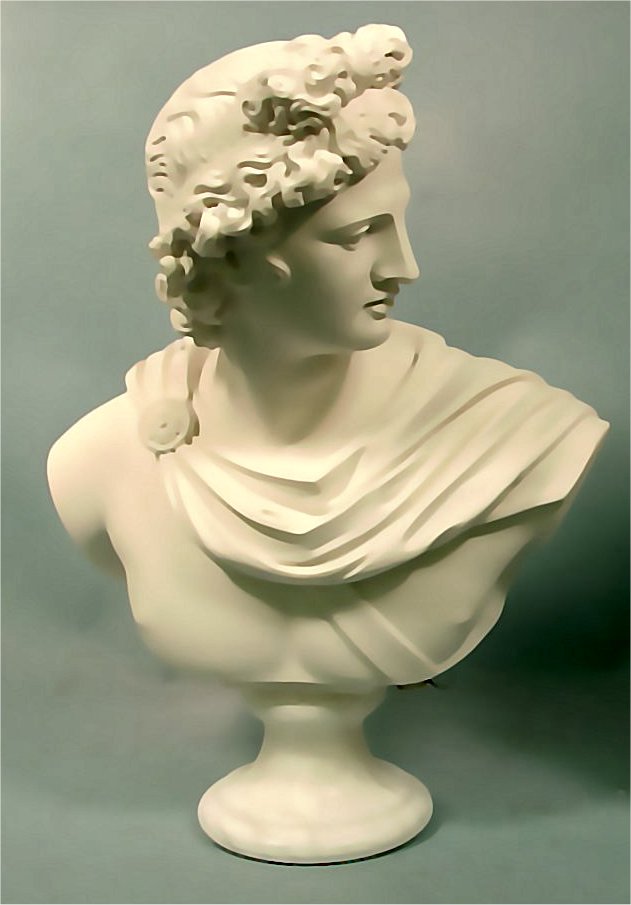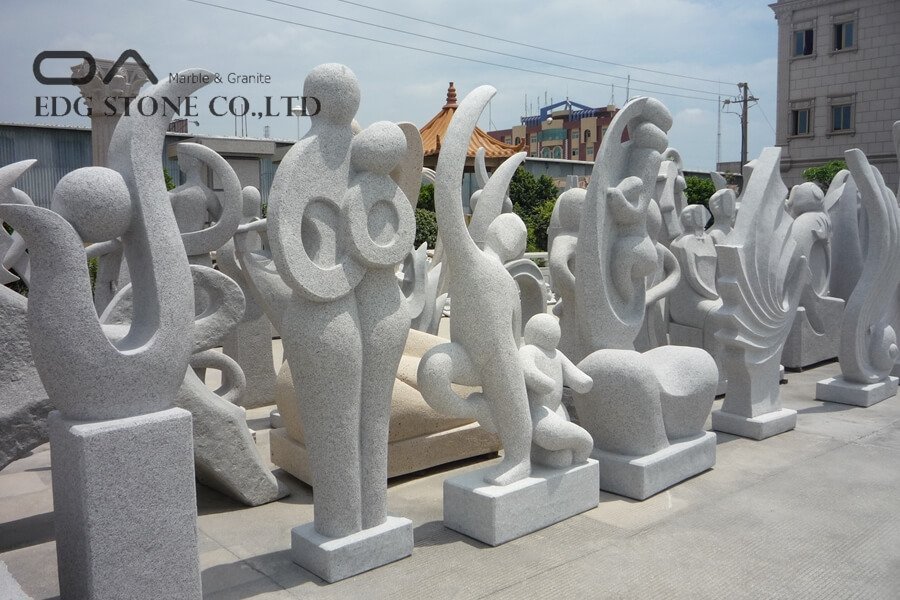In today’s modern world, where technology and digital media dominate our lives, it is easy to forget the beauty and artistry that can be found in the simplest of things. One such example of this is sculptures. Sculptures have been part of human history for thousands of years, with different cultures and civilizations leaving behind their unique and captivating creations.
Ancient Greek Sculptures – A Glimpse into Mythology and History
One of the most famous and enduring forms of sculptures is the ancient Greek sculptures. These sculptures depict gods, goddesses, mythological creatures, and heroes from Greek mythology. They provide us with a glimpse into the rich mythology and history of ancient Greece.

A beautiful example of an ancient Greek sculpture is the statue of a woman in the garden. With its intricate details and flawless craftsmanship, this sculpture showcases the skill and artistry of the ancient Greeks. It is a testament to their dedication and reverence for beauty and aesthetics.
Classical Sculptures – Timeless Beauty and Elegance
The classical sculptures, inspired by the ancient Greeks and Romans, are known for their timeless beauty and elegance. These sculptures capture the essence of human emotions and expressions, bringing them to life in stone.
One such classical sculpture is the ancient Greek sculpture of a woman. With its delicate features and graceful pose, this sculpture evokes a sense of tranquility and serenity. It is a reminder of the beauty and elegance that can be found in simplicity.
The Fantastic Ancient Greek Sculpture of Apoxiomen
Among the many ancient Greek sculptures, one that stands out is the fantastic sculpture of Apoxiomen. This Croatian masterpiece showcases the skill and artistry of the sculptor, capturing the essence of the human form in exquisite detail.

From the intricate muscles and facial features to the dynamic pose, every aspect of this sculpture is a testament to the mastery of its creator. It is a sculpture that demands attention and admiration, leaving viewers in awe of its sheer beauty and craftsmanship.
A Breathtaking Sculptural Bust
Another remarkable example of sculpture is the Apollo Belvedere Sculptural Bust. This marble sculpture depicts the Greek god Apollo, known for his beauty, grace, and artistic abilities.

The Apollo Belvedere Sculptural Bust is a true masterpiece, with its lifelike features and intricate details. It captures the essence of Apollo, showcasing his ethereal beauty and divine presence. It is a sculpture that transcends time and continues to inspire awe and admiration.
Stone Garden Statues – Adding Elegance and Charm to Your Outdoor Space
Stone garden statues have long been used to adorn and enhance outdoor spaces. They add an element of elegance and charm, creating a focal point that draws the eye and captures the imagination.

One such example of stone garden statues is the granite stone garden statues for sale. These statues, carved from high-quality granite, are not only durable but also incredibly beautiful. They come in various designs and styles, allowing you to choose the one that complements your outdoor space.
The Importance of Planning in Sculpture
When it comes to creating sculptures, planning plays a crucial role. It involves carefully considering the design, materials, and techniques that will be used to bring the sculpture to life. Without proper planning, a sculpture can lack cohesiveness and fail to convey the intended message or emotion.
Whether you are a professional sculptor or someone with a passion for sculpting, taking the time to plan your sculpture is essential. It allows you to visualize the final result, identify any potential challenges, and make the necessary adjustments before starting the actual work.
During the planning phase, it is important to consider various factors, such as the theme or concept of the sculpture, the intended location, and the audience or viewers who will experience it. This will help guide your decisions and ensure that your sculpture resonates with its surroundings and audience.
Design Style in Sculpture – Exploring Different Aesthetic Approaches
Design style is an integral part of sculpture, as it influences the overall aesthetic and visual impact of the artwork. Different design styles can evoke different emotions and convey distinct messages, allowing artists to express their creativity and vision in unique ways.
When choosing a design style for your sculpture, consider the theme or subject matter you wish to portray. For example, if you are creating a sculpture inspired by nature, you may opt for a more organic and flowing design style. On the other hand, if you want to convey strength and power, a more angular and geometric design style may be suitable.
Experimenting with different design styles can be a great way to push the boundaries of your creativity and explore new artistic possibilities. Whether you prefer abstract or realistic styles, each design choice will contribute to the overall impact of your sculpture.
The Elements of Sculpture – Exploring Form, Space, and Texture
Sculptures are not only defined by their subject matter and design style but also by the elements that make up their physical composition. These elements, including form, space, and texture, add depth and richness to the sculpture, making it more engaging and visually appealing.
The form of a sculpture refers to its three-dimensional shape or structure. It encompasses the physical dimensions, proportions, and contours of the artwork. By carefully shaping the form, artists can create a sense of balance, harmony, and movement in their sculptures.
Space plays a vital role in sculpture, as it defines the relationship between the artwork and its surroundings. It can be used to create a sense of depth, perspective, and interaction with the viewer. Artists often consider the negative space or the empty areas around and within the sculpture, as it contributes to the overall composition and visual impact.
Texture adds another layer of visual interest to sculptures. It refers to the surface quality of the artwork, whether it is smooth, rough, or somewhere in between. Texture can be achieved through various techniques, such as carving, sculpting, or adding materials with different textures to the sculpture.
By carefully considering and manipulating these elements, artists can create sculptures that captivate viewers and evoke a range of emotions and responses.
Layout and Structure in Sculpture – Creating a Harmonious Composition
Layout and structure are essential aspects of sculpture, as they determine how the various elements and components come together to create a harmonious composition. A well-planned layout and structure ensure that the sculpture is visually appealing, balanced, and cohesive.
When designing the layout and structure of a sculpture, it is important to consider the intended viewing angle and perspective. This will help determine the placement and arrangement of different elements, ensuring that the sculpture is visually striking from all angles.
In addition, the structure of the sculpture should be sturdy and stable, especially if it is intended for outdoor display. The materials used should be able to withstand environmental factors such as wind, rain, and temperature changes. Proper reinforcement and support may be necessary to ensure the longevity of the sculpture.
Furniture and Decor – Enhancing Your Space with Sculptural Elements
Sculptures are not limited to museums and art galleries. They can also be incorporated into our homes and living spaces, adding a touch of elegance and sophistication to our surroundings.
When choosing furniture and decor pieces for your space, consider incorporating sculptural elements. A sculpture can serve as a focal point in a room, drawing the eye and becoming a conversation starter. It can also add personality and character, reflecting your unique style and interests.
There are various ways to incorporate sculptures into your space. For example, you can place a small sculpture on a mantel or shelf, or choose a larger sculpture as a centerpiece for a coffee table or console. You can also opt for sculptural furniture pieces, such as chairs or tables, that combine functionality with artistic flair.
By integrating sculptures into your space, you create a visual narrative that reflects your taste and appreciation for art. It adds a layer of sophistication and uniqueness that elevates your space from ordinary to extraordinary.
Personalizing Your Sculptures – Adding Your Unique Touch
While there is great beauty in traditional and classical sculptures, there is also something special about creating your own sculptures and adding a personal touch.
Personalizing your sculptures allows you to express your creativity and individuality. It gives you the freedom to experiment with different materials, techniques, and styles, creating artworks that are a true reflection of your artistic vision.
When personalizing your sculptures, consider incorporating elements that are meaningful to you. It could be a symbol, a specific color palette, or even materials that hold personal significance. By infusing your sculptures with personal meaning, you create a deeper connection to the artwork and enable others to connect with it on a more profound level.
How to Create Sculptures – Tips and Techniques for Beginners
If you are new to sculpture and interested in exploring this artistic medium, here are some tips and techniques to help you get started:
1. Start with a concept: Before diving into the physical creation of a sculpture, have a clear concept or idea in mind. This will guide your decision-making process and ensure that your sculpture conveys the intended message or emotion.
2. Choose the right materials: Depending on your chosen style and concept, select the appropriate materials for your sculpture. Consider factors such as durability, texture, and ease of manipulation.
3. Sketch or create a model: Before working with the actual materials, sketch or create a model of your sculpture. This will allow you to visualize your ideas and make necessary adjustments before committing to the final sculpture.
4. Learn basic sculpting techniques: Familiarize yourself with basic sculpting techniques such as carving, molding, and casting. These techniques will form the foundation of your sculpture-making skills.
5. Practice patience and perseverance: Sculpture is a meticulous and time-consuming process. It requires patience and perseverance to achieve the desired results. Embrace the journey and be open to learning from your mistakes.
6. Seek inspiration and guidance: Look at the works of established sculptors for inspiration. Join art classes or workshops to learn from experienced artists who can provide guidance and feedback on your work.
7. Experiment and take risks: Don’t be afraid to experiment with different materials, techniques, and styles. Taking risks can lead to unexpected discoveries and unique artistic expressions.
Remember, creating sculptures is a personal and artistic journey. Embrace the creative process, and let your imagination guide you as you bring your sculptures to life.
In conclusion, sculptures are a testament to human creativity, skill, and imagination. From ancient Greek sculptures that transport us to a world of mythology and history to modern stone garden statues that enhance our outdoor spaces, sculptures have the power to captivate, inspire, and evoke emotions.
Whether you are an avid art enthusiast or someone with a budding interest in sculpting, exploring the world of sculptures opens up a whole new world of artistic possibilities. So go ahead, indulge your curiosity, and discover the captivating beauty of sculptures.